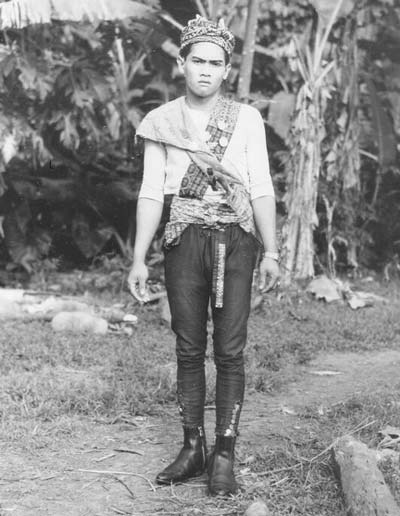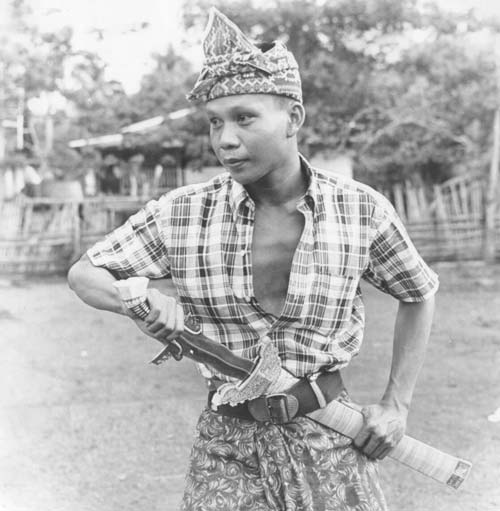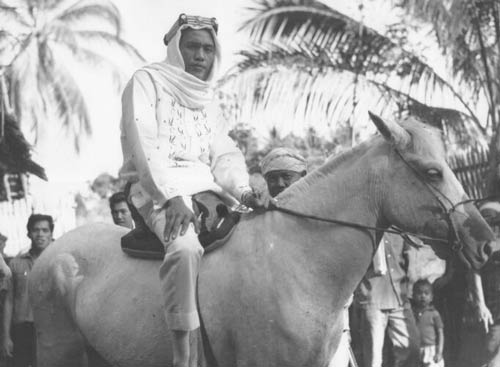
HOME
WEDDING
CUSTOMS
| Tausug Marriages: |
| Introduction: The Tausug People |
| Part One: Courtship |
| Part Two: Arranged Mariages |
| Part Three: Abduction and Elopement |
| Part Four: Weddings and Divorces |
Philippine Muslim (Tausug) Marriages
on Jolo Island
Philippine Muslim (Tausug) Marriages
on Jolo Island
Part Three: Abduction and Elopement
|
Man with kalis (kris). While guns have replaced swords as practical weapons, bladed weapons still have importance as symbols of masculinity and bravery. |
Abduction and Elopement
Abduction is a quick, relatively inexpensive, highly individual strategy for a young man to get the girl he desires who might otherwise not be available. It is also a highly spicy and "fun" thing to do as an expression of one's masculinity in a culture which puts a very high value on bravery and masculinity. In spite of their seriousness, abductions are a game, and appeal to young men precisely because of the risk. About one quarter of marriages are abductions, at least in the area where I did my research.
One of my informants, Naju, abducted both his wives. When he was a boy he made a solemn promise (najal) that he would always abduct his wives. Since he was a rather spoiled younger son, his parents agreed that they would support him. He said he abducted his first wife a week after he first decided he loved her. One day when she was alone at the waterhole he grabbed her and carried her to the sara (the headman, from Islamic Shari'ah, law). She screamed loudly, but whatever her private feelings were, it is always necessary to put on a show of resisting. Her parents were extremely upset. But the headman's house is considered a sanctuary in these matters and the authority for the marriage negotiations rests with him. There is a specific schedule for brideweath and fines , in the past fixed by the Sultan. Although it is higher now, when I did my research it was 140 pesos plus 50 pesos "to reduce the shame of the girl". Usually the headman also takes a percentage of the fine. In theory the girl has the right to refuse to marry her captor, but in practice this seldom happens. If a young man suspects she may be reluctant, he may take her into the forest before going to the headman and seduce her, making it difficult for her to refuse to marry him.
 |
Naju abducted his second wife several months after divorcing the first. He decided he wanted a certain unmarried girl and invited several friends and female kinsmen to help in the abduction. He approached her on a trail, but she sensed his intentions and fled. She was accompanied by her cousin who was prevented from hacking Naju with his sword by the timely intervention of one of the women. Another woman ran after the young lady and carried her to the headman's house. Fifty pesos were immediately sent to her parents to "hide the shame." They sent word that they wished a bridewealth of 500 pesos, one cow, and three sacks of rice. While this is more than the minimum standard specified in the law for an abduction, it was accepted. They were married two days later in the headman's home. All negotiations are in his hands; the function of the minimum standard bridewealth legitimized by the law (sara) is to give the headman a bargaining position to fall back against if the girl's parents prove to be uncooperative.
The gamelike quality of abductions -in spite of the seriousness with which they are viewed by the girl's parents and the real possibility of violence if the boy is caught before he can reach the headman's house- is illustrated by the rule whereby it is customary in some situations to deliver a piece of old heirloom brass to the parents of the girl. The boy's messenger must carefully place the object on their porch before they discover his presence; they have the right to "capture" him and demand the payment of a further fine of 25 pesos upon his release. Although abductions usually involve the use of force, or at least the appearance of the use of force (everybody is supposed to scream and yell and shoot their guns), there is a simple symbolic form of abduction. Magtagubay involves a deliberate public touching of the woman by the man or in some instances his agent (often a female relative) who touches her and an­nounces it is on his behalf. The marriage pro­ceeds as if it were a regular abduction, although it is easier for the woman to decline.
Although bridewealth for an abduction is fixed as a legal minimum, the young man or his parents may offer more as a gesture of appeasement.. There is some regional variation in these legal minimum figures, and in cases where one party comes from a distant region with slightly different adat (customary) law, there will be negotiation as to the standard to apply. In some cases, conflicts of law were appealed to the sultan, or more recently regional politicians. But the bridewealth for abduction is almost al­ways lower than for an arranged marriage. Furthermore, it is possible for the young man to know in advance exactly how much he will be asked to pay. In some instances he will simply bring the money with him; in others he will at least have calculated the amount im­mediately available through his own savings, his parents' resources, and the amount which will certainly be contributed by other close kinsmen. Failure to pay the minimum bride­wealth after an abduction is an almost certain cause for a feud, but such instances are very rare.
|
|
My observations must necessarily be very subjective, but men who resort to abduction tend to fall into one of two extreme types. Many are very self assured, strong personalities with a pronounced masculine (maisug - very masculine or brave) and almost "macho" style. Others, however, often have some weakness which would make them less than desirable matches in an arranged marriage: unattractiveness, physical disability, poverty, lack of intelligence, reputation for cowardice or laziness, etc. Abduction is an assured, quicker, and usually less expensive marriage strategy. It is also proven way to get a second wife easily, although plural marriages are not common among the Tausug, even among the wealthy.
The line dividing an abduction from an elopement is very thin. In Tausug belief an abduction is due to the desire of the boy, while an elopement implies desire on the part of the girl. Most girls would rather be abducted than admit to elopement. The couple just run away to the sanctuary of the headman's house, and he arranges the bridewealth which is always less than an abduction or arranged marriage. There is also a symbolic form of elopement called "going home to obtain a husband" (muuy magbana) in which a woman presents herself to the man or his parents announcing her desire to marry him. If he accepts (he usually does) the marriage proceeds as if it were a regular elopement. This form is much more likely in second marriages for experienced women. The seduction of a younger man by an older unmarried woman is also put in this category. It is relatively rare.


